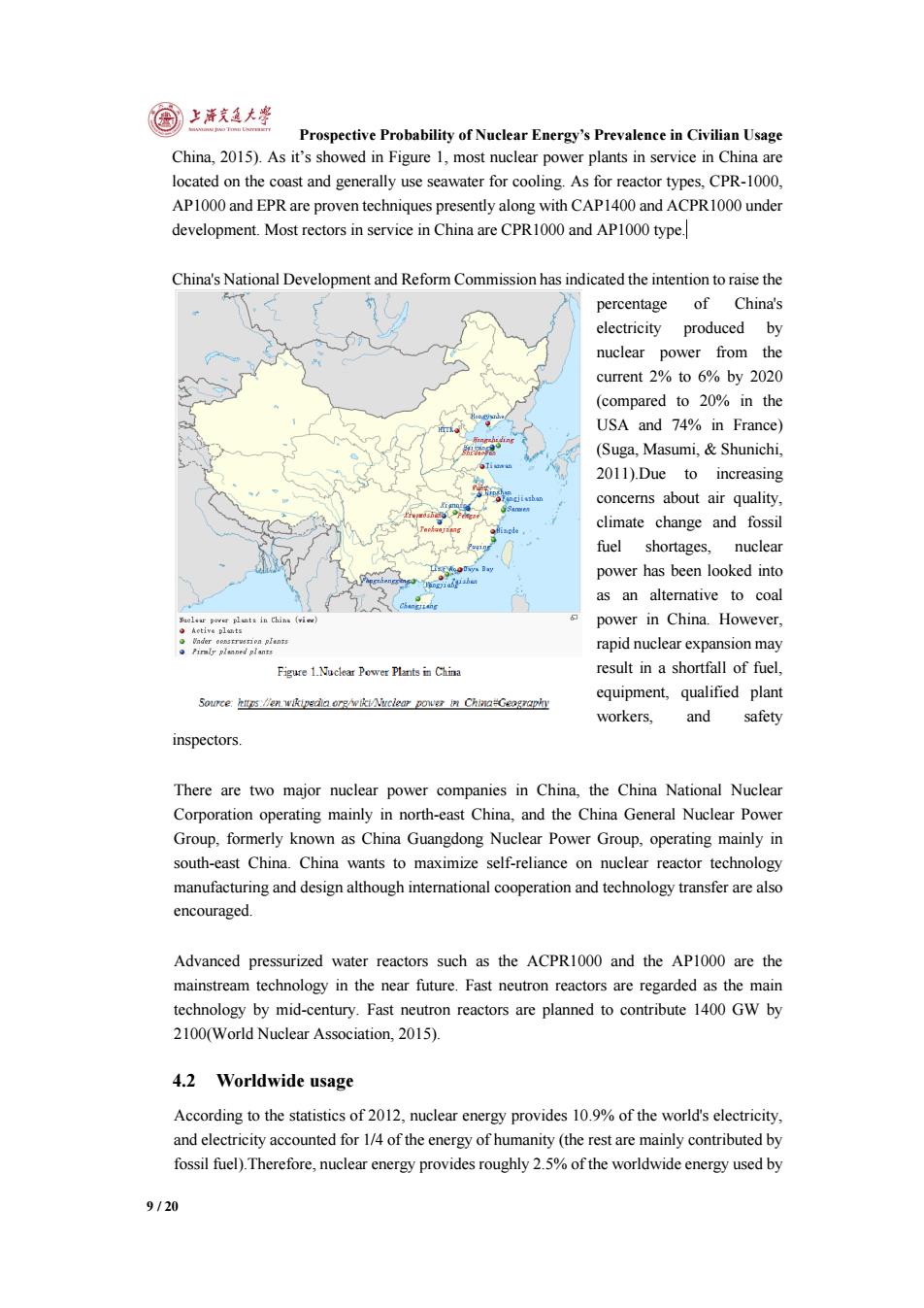正在加载图片...

Prospective Probability of Nuclear Energy's Prevalence in Civilian Usage China,2015).As it's showed in Figure 1,most nuclear power plants in service in China are located on the coast and generally use seawater for cooling.As for reactor types,CPR-1000, AP1000 and EPR are proven techniques presently along with CAP1400 and ACPR1000 under development.Most rectors in service in China are CPR1000 and AP1000 type. China's National Development and Reform Commission has indicated the intention to raise the percentage of China's electricity produced by nuclear power from the current 2%to 6%by 2020 (compared to 20%in the USA and 74%in France) (Suga,Masumi,Shunichi, 2011).Due to increasing concerns about air quality, climate change and fossil fuel shortages, nuclear power has been looked into as an alternative to coal power in China.However, ve plo rapid nuclear expansion may Figure 1.Nuclear Power Plants in China result in a shortfall of fuel, equipment,qualified plant Source:https/en.wikipedia org/wikiNuclear power in ChinaGeography workers, and safety inspectors. There are two major nuclear power companies in China,the China National Nuclear Corporation operating mainly in north-east China,and the China General Nuclear Power Group,formerly known as China Guangdong Nuclear Power Group,operating mainly in south-east China.China wants to maximize self-reliance on nuclear reactor technology manufacturing and design although international cooperation and technology transfer are also encouraged. Advanced pressurized water reactors such as the ACPR1000 and the AP1000 are the mainstream technology in the near future.Fast neutron reactors are regarded as the main technology by mid-century.Fast neutron reactors are planned to contribute 1400 GW by 2100(World Nuclear Association,2015). 4.2 Worldwide usage According to the statistics of 2012,nuclear energy provides 10.9%of the world's electricity, and electricity accounted for 1/4 of the energy of humanity(the rest are mainly contributed by fossil fuel).Therefore,nuclear energy provides roughly 2.5%of the worldwide energy used by 9/20Prospective Probability of Nuclear Energy’s Prevalence in Civilian Usage 9 / 20 China, 2015). As it’s showed in Figure 1, most nuclear power plants in service in China are located on the coast and generally use seawater for cooling. As for reactor types, CPR-1000, AP1000 and EPR are proven techniques presently along with CAP1400 and ACPR1000 under development. Most rectors in service in China are CPR1000 and AP1000 type. China's National Development and Reform Commission has indicated the intention to raise the percentage of China's electricity produced by nuclear power from the current 2% to 6% by 2020 (compared to 20% in the USA and 74% in France) (Suga, Masumi, & Shunichi, 2011).Due to increasing concerns about air quality, climate change and fossil fuel shortages, nuclear power has been looked into as an alternative to coal power in China. However, rapid nuclear expansion may result in a shortfall of fuel, equipment, qualified plant workers, and safety inspectors. There are two major nuclear power companies in China, the China National Nuclear Corporation operating mainly in north-east China, and the China General Nuclear Power Group, formerly known as China Guangdong Nuclear Power Group, operating mainly in south-east China. China wants to maximize self-reliance on nuclear reactor technology manufacturing and design although international cooperation and technology transfer are also encouraged. Advanced pressurized water reactors such as the ACPR1000 and the AP1000 are the mainstream technology in the near future. Fast neutron reactors are regarded as the main technology by mid-century. Fast neutron reactors are planned to contribute 1400 GW by 2100(World Nuclear Association, 2015). 4.2 Worldwide usage According to the statistics of 2012, nuclear energy provides 10.9% of the world's electricity, and electricity accounted for 1/4 of the energy of humanity (the rest are mainly contributed by fossil fuel).Therefore, nuclear energy provides roughly 2.5% of the worldwide energy used by